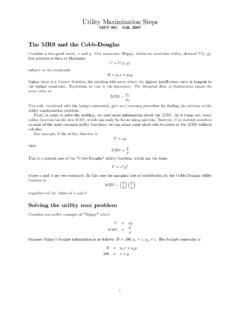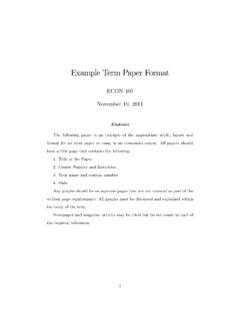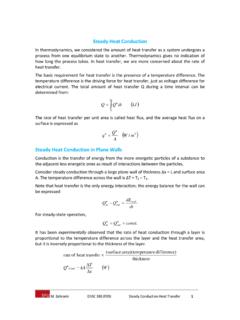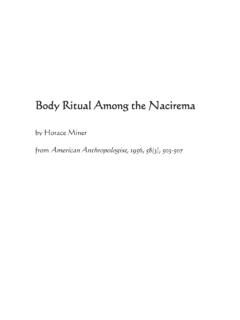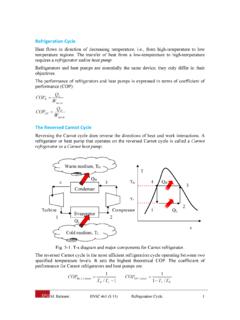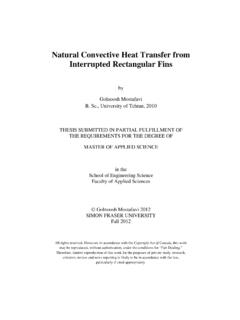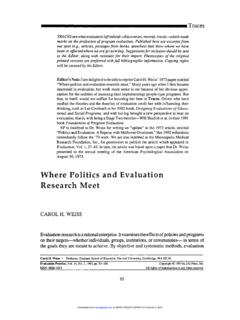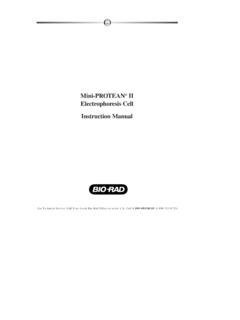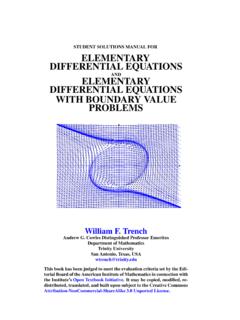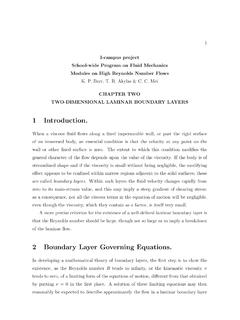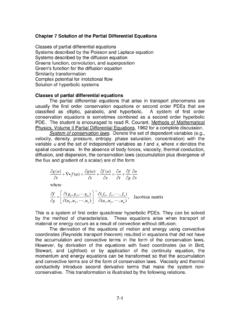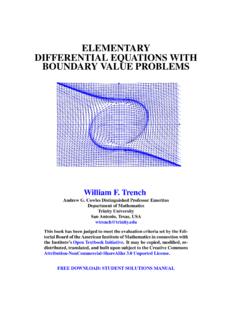Transcription of First Law of Thermodynamics Closed Systems - SFU.ca
1 M. Bahrami ENSC 388 (F09) 1st Law of Thermodynamics : Closed Systems 1 The First Law of Thermodynamics : Closed Systems The First law of Thermodynamics can be simply stated as follows: during an interaction between a system and its surroundings, the amount of energy gained by the system must be exactly equal to the amount of energy lost by the surroundings. A Closed system can exchange energy with its surroundings through heat and work transfer. In other words, work and heat are the forms that energy can be transferred across the system boundary . Based on kinetic theory, heat is defined as the energy associated with the random motions of atoms and molecules. Heat Transfer Heat is defined as the form of energy that is transferred between two Systems by virtue of a temperature difference. Note: there cannot be any heat transfer between two Systems that are at the same temperature. Note: It is the thermal (internal) energy that can be stored in a system .
2 Heat is a form of energy in transition and as a result can only be identified at the system boundary . Heat has energy units kJ (or BTU). Rate of heat transfer is the amount of heat transferred per unit time. Heat is a directional (or vector) quantity; thus, it has magnitude, direction and point of action. Notation: Q (kJ) amount of heat transfer Q (kW) rate of heat transfer (power) q (kJ/kg) heat transfer per unit mass q (kW/kg) power per unit mass Sign convention: Heat Transfer to a system is positive, and heat transfer from a system is negative. It means any heat transfer that increases the energy of a system is positive, and heat transfer that decreases the energy of a system is negative. M. Bahrami ENSC 388 (F09) 1st Law of Thermodynamics : Closed Systems 2 Fig. 1: Sign convention: positive if to the system , negative if from the system . Modes of Heat Transfer Heat can be transferred in three different modes conduction, convection, and radiation.
3 All modes of heat transfer require the existence of a temperature difference. Conduction: is the transfer of energy from the more energetic particles to the adjacent less energetic particles as a result of interactions between particles. In solids, conduction is due to the combination of vibrations of the molecules in a lattice and the energy transport by free electrons. Convection: is the mode of energy transfer between a solid surface and the adjacent liquid or gas which is in motion, and it involves the combined effects of conduction and fluid motion (advection). Convection is called forced if the fluid is forced to flow by external means such as a fan or a pump. It is called free or natural if the fluid motion is caused by buoyancy forces that are induced by density differences due to the temperature variation in a fluid. Radiation: is the energy emitted by matter in the form of electromagnetic waves (or photons) as a result of the changes in the electronic configurations of the atoms or molecules.
4 Work Work is the energy interaction between a system and its surroundings. More specifically, work is the energy transfer associated with force acting through a distance. Notation: W (kJ) amount of work transfer W (kW) power Q = 5 kJ Q = 5 kJ Heat in Heat out system M. Bahrami ENSC 388 (F09) 1st Law of Thermodynamics : Closed Systems 3 w (kJ/kg) work per unit mass w (kW/kg) power per unit mass Sign convention: work done by a system is positive, and the work done on a system is negative. Fig. 2: Sign convention for heat and work. Similarities between work and heat transfer: Both are recognized at the boundaries of the system as they cross them ( boundary phenomena). Systems posses energy, but not heat or work (transfer phenomena). Both are associated with a process, not a state. Heat or work has no meaning at a state. Both are path functions, their magnitudes depend on the path followed during a process as well as the end states.
5 Path functions: have inexact differentials designated by symbol . Properties, on the other hand, are point functions which depend on the state only (not on how a system reaches that state), and they have exact differentials. )W-nor WW not function,Path (Wfunction)(Point 1212211221 WVVVdV Electrical Work The work that is done on a system by electrons. When N coulombs of electrons move through a potential difference V, the electrical work done is: system Q W (+) ( ) (+) ( ) M. Bahrami ENSC 388 (F09) 1st Law of Thermodynamics : Closed Systems 4 )(Was form rate in the explained becan Which )(ekWVIkJVNWe Example 1: Electrical work A well insulated electrical oven is being heated through its heating element. Determine whether it is work or heat interaction. Consider two Systems : a) the entire oven (including the heater), and b) only the air in the oven (without the heater) see Fig 3 3. Solution: The energy content of the oven is increased during this process.
6 A) The energy transfer to the oven is not caused by a temperature difference between the oven and air. Instead, it is caused by electrical energy crossing the system boundary and thus: this is a work transfer process. b) This time, the system boundary includes the outer surface of the heater and will not cut through it. Therefore, no electrons will be crossing the system boundary . Instead, the energy transfer is a result of a temperature difference between the electrical heater and air, thus: this is a heat transfer process. Fig. 3: Schematic for example 1. Mechanical work There are several ways of doing work, each in some way related to a force acting through a distance. )(.kJsFW Electric oven air Heater Heater Electric oven air system boundary system boundary M. Bahrami ENSC 388 (F09) 1st Law of Thermodynamics : Closed Systems 5 If the force is not constant, we need to integrate: 21)(.kJdsFW There are two requirements for a work interaction: there must be a force acting on the boundary the boundary must move Therefore, the displacement of the boundary without any force to oppose or drive this motion (such as expansion of a gas into evacuated space) is not a work interaction, W=0.
7 Also, if there are no displacements of the boundary , even if an acting force exists, there will be no work transfer W = 0 (such as increasing gas pressure in a rigid tank). Moving boundary Work The expansion and compression work is often called moving boundary work, or simply boundary work. We analyze the moving boundary work for a quasi equilibrium process. Consider the gas enclosed in a piston cylinder at initial P and V. If the piston is allowed to move a distance ds in a quasi equilibrium manner, the differential work is: PdVPAdsdsFWb . The quasi equilibrium expansion process is shown in Fig. 4. On this diagram, the differential area dA under the process curve in P V diagram is equal to PdV, which is the differential work. Note: a gas can follow several different paths from state 1 to 2, and each path will have a different area underneath it (work is path dependent). The net work or cycle work is shown in Fig. 5. In a cycle, the net change for any properties (point functions or exact differentials) is zero.
8 However, the net work and heat transfer depend on the cycle path. U = P = T = (any property) = 0 for a cycle M. Bahrami ENSC 388 (F09) 1st Law of Thermodynamics : Closed Systems 6 Fig. 4: the area under P V diagram represents the boundary work. Fig. 5: network done during a cycle. Polytropic Process During expansion and compression processes of real gases, pressure and volume are often related by PVn=C, where n and C are constants. The moving work for a polytropic process can be found: nVPVPdVCVPdVWnpolytopic 111222121 Since CVPVPnn 2211. For an ideal gas (PV= mRT) it becomes: V P Wnet1 2 V1 V2 M. Bahrami ENSC 388 (F09) 1st Law of Thermodynamics : Closed Systems 7 )(1,112kJnnTTmRWpolytropic The special case n =1 is the isothermal expansion P1V1 = P2V2 = mRT0= C, which can be found from: )(1,ln12112121,kJnVVVPdVVCPdVWisothermal b Since for an ideal gas, PV=mRT0 at constant temperature T0, or P=C/V.
9 Example 2: Polytropic work A gas in piston cylinder assembly undergoes a polytropic expansion. The initial pressure is 3 bar, the initial volume is m3, and the final volume is m3. Determine the work for the process, in kJ, if a) n= , b) n= , and c) n=0. Solution: Assume that i) the gas is a Closed system , ii) the moving boundary is only work mode, and iii) the expansion is polytropic. a) n = 2111221 VVnVPVPPdVW We need P2 that can be found fromnnVPVP2211 : b) n =1, the pressure volume relationship is PV = constant. The work is: c) For n = 0, the pressure volume relation reduces to P=constant (isobaric process) and the integral become W= P (V2 V1). Substituting values and converting units as above, W=30 kJ. M. Bahrami ENSC 388 (F09) 1st Law of Thermodynamics : Closed Systems 8 Spring work For linear elastic springs, the displacement x is proportional to the force applied: xkFs where ks is the spring constant and has the unit kN/m.
10 The displacement x is measured from the undisturbed position of the spring. The spring work is: )(212122kJxxkWsspring Note: the work done on a spring equals the energy stored in the spring. Non mechanical forms of work Non mechanical forms of work can be treated in a similar manner to mechanical work. Specify a generalized force F acting in the direction of a generalized displacement x, the work transfer associated with the displacement dx is: dxFW. Example 3: Mechanical work Calculate the work transfer in the following process: Fig. 6: Schematic P V diagram for Example 3. Solution: Process 1 2 is an expansion (V2 > V1) and the system is doing work (W12 >0), thus: W12 = P1 (V2 V1) + [ (P1+P2) P1] (V2 V1) = (V2 V1) (P1 + P2) / 2 Process 2 3 is an isometric process (constant volume V3 = V2), so W23 = 0 Process 3 1 is a compression (V3 > V1), work is done on the system , (W31< 0) 12 3 V V2 V1 P1 P2 P M. Bahrami ENSC 388 (F09) 1st Law of Thermodynamics : Closed Systems 9 W31 = P1 (V2 V1) Wcycle = Wnet = W12 + W23 + W31 = (V2 V1) (P2 P1) / 2 Note that in a cycle U = P = T = (any property) = 0 First Law of Thermodynamics First law, or the conservation of energy principle, states that energy can be neither created nor destroyed; it can only change forms.
